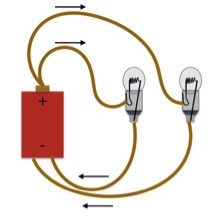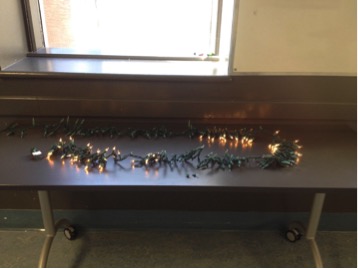
It’s that time of year when some of us head to the woods with a saw (or to the tree lot), dust off our boxes of decorations and bring a Christmas tree to life. Arguably the most important trimming a beautiful Christmas tree are the twinkling Christmas lights. Have you ever broken one of the lightbulbs and had the whole string go out? Did you wonder why all of them went out instead of just one (while you were painstakingly checking each and every light bulb)? Well, hold on to that string of lights, because they are an excellent and fun tool to learn about electric circuits.
First of all, let’s talk about series and parallel circuits. In order for the bulb to glow, you need a circuit. A circuit is a complete loop or path for current to flow from the positive side of a socket to the lights and then back to the negative side of the socket. It’s handy to remember is that current electricity always needs to flow in a loop.
A series circuit is when many lights are connected in the same circuit loop. The current is flowing from the power source, through the lights, and then back to the power source. If you take a light bulb out of the series circuit (or break one), the current can no longer flow in a loop and therefore, none of the lights come on.
 Light bulbs wired in a series circuit. (Source here)
Light bulbs wired in a series circuit. (Source here)
Parallel circuits on the other hand, give the current other options or other loops to complete the path back to the power source. Therefore, if you break a lightbulb in one loop, the current has other loops to flow through which allows them to stay on even with a broken light.
 Light bulbs wired in a parallel circuit. (Source: here)
Light bulbs wired in a parallel circuit. (Source: here)
Modern Christmas lights are a combination of series and parallel circuits. Let’s try to figure out where these different circuits are. Please note that adult supervision is always recommended when working with electrical currents.
Materials you’ll need:
Electric outlet
String of Christmas lights (incandescent lights work best)
Procedure:
Start with a string of Christmas lights. Incandescent lights and other old school Christmas lights work best because the light bulbs are easier to take out.
Plug the lights in and see if all of the bulbs light up.
Take any bulb (other than the very first one) out of the lights near the beginning of the sting of lights (closer to the plug) and see that a section of the lights go out but the others further down are still on.
Put the light bulb back in its place.
Go further down the string of lights and remove a light bulb. You will see that the start of the lights and the end of the lights are on, but a section of the lights in the middle are out.
Replace the bulb and try taking the bulb out at other various places or try taking out more than one bulb at different places and see what happens.
The section of the lights that go out all together are wired in a series circuit. All of the lights are in the same loop for the current to flow through, so when you make a break in the circuit loop, the electrons cannot flow in a complete circle anymore. However, the rest of the Christmas lights stay on because they are wired in a parallel circuit. This means that there are other loops of lights wired in the circuit that the electrons can flow through when one of the rows of lights has a break in the circuit. Therefore, the Christmas lights are a combination of series and parallel circuits.
Further exploring
Count how many parallel sections there are and try drawing out the series and parallel circuits of your string of Christmas lights.
For my lights, I had five series circuits wired in parallel.
For more great things to discover – visit the Discovery Centre on Barrington Street in Halifax, check out their website or join them on facebook.

